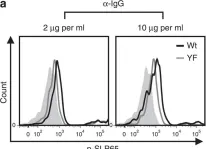Peripheral tolerance prevents the initiation of damaging immune responses by autoreactive lymphocytes. While tolerogenic mechanisms are tightly regulated by antigen-dependent and independent signals, downstream pathways are incompletely understood. N-myc downstream-regulated gene 1 (NDRG1), an anti-cancer therapeutic target, has previously been implicated as a CD4+ T cell clonal anergy factor. By RNA-sequencing, we identified Ndrg1 as the third most upregulated gene in anergic, compared to naïve follicular, B cells. Ndrg1 is upregulated by B cell receptor activation (signal one) and suppressed by co-stimulation (signal two), suggesting that NDRG1 may be important in B cell tolerance. However, though Ndrg1-/- mice have a neurological defect mimicking NDRG1-associated Charcot-Marie-Tooth (CMT4d) disease, primary and secondary immune responses were normal. We find that B cell tolerance is maintained, and NDRG1 does not play a role in downstream responses during re-stimulation of in vivo antigen-experienced CD4+ T cells, demonstrating that NDGR1 is functionally redundant for lymphocyte anergy.
© 2022. The Author(s).
Product Citations: 4
NDRG1 is induced by antigen-receptor signaling but dispensable for B and T cell self-tolerance.
In Communications Biology on 10 November 2022 by Hodgson, R., Xu, X., et al.
-
FC/FACS
-
Mus musculus (House mouse)
-
Immunology and Microbiology
In Frontiers in Immunology on 25 July 2017 by Fasbender, F., Claus, M., et al.
In a synthetic biology approach using Schneider (S2) cells, we show that SLP-76 is directly phosphorylated at tyrosines Y113 and Y128 by SYK in the presence of ITAM-containing adapters such as CD3ζ, DAP12, or FcεRγ. This phosphorylation was dependent on at least one functional ITAM and a functional SH2 domain within SYK. Inhibition of Src-kinases by inhibitors PP1 and PP2 did not reduce SLP-76 phosphorylation in S2 cells, suggesting an ITAM and SYK dependent, but Src-kinase independent signaling pathway. This direct ITAM/SYK/SLP-76 signaling pathway therefore differs from previously described ITAM signaling. However, the SYK-family kinase ZAP70 required the additional co-expression of the Src-family kinases Fyn or Lck to efficiently phosphorylate SLP-76 in S2 cells. This difference in Src-family kinase dependency of SYK versus ZAP70-mediated ITAM-based signaling was further demonstrated in human lymphocytes. ITAM signaling in ZAP70-expressing T cells was dependent on the activity of Src-family kinases. In contrast, Src-family kinases were partially dispensable for ITAM signaling in SYK-expressing B cells or in natural killer cells, which express SYK and ZAP70. This demonstrates that SYK can signal using a Src-kinase independent ITAM-based signaling pathway, which may be involved in calibrating the threshold for lymphocyte activation.
-
Immunology and Microbiology
In Nature Communications on 7 December 2016 by Blanc, P., Moro-Sibilot, L., et al.
Dogma holds that plasma cells, as opposed to B cells, cannot bind antigen because they have switched from expression of membrane-bound immunoglobulins (Ig) that constitute the B-cell receptor (BCR) to production of the secreted form of immunoglobulins. Here we compare the phenotypical and functional attributes of plasma cells generated by the T-cell-dependent and T-cell-independent forms of the hapten NP. We show that the nature of the secreted Ig isotype, rather than the chemical structure of the immunizing antigen, defines two functionally distinct populations of plasma cells. Fully mature IgM-expressing plasma cells resident in the bone marrow retain expression of a functional BCR, whereas their IgG+ counterparts do not. Antigen boost modifies the gene expression profile of IgM+ plasma cells and initiates a cytokine production program, characterized by upregulation of CCL5 and IL-10. Our results demonstrate that IgM-expressing plasma cells can sense antigen and acquire competence for cytokine production upon antigenic challenge.
-
Immunology and Microbiology
In Nature Communications on 13 October 2015 by Lutz, J., Dittmann, K., et al.
Secondary antibody responses are marked by faster kinetics, improved antibody affinity and a switch from IgM to other immunoglobulin isotypes, most notably IgG, compared with primary responses. These changes protect from reinfection and represent the principle of most vaccination strategies. Yet, the molecular mechanisms that underlie B-cell memory responses are unclear. Here we show, by inactivating the immunoglobulin tail tyrosine (ITT) signalling motif of membrane-bound IgG1 in the mouse, that the ITT facilitates maintenance and reactivation of IgG-switched memory B cells in vivo. The ITT motif equips IgG-switched cells with enhanced BCR signalling capacity, which supports their competitiveness in secondary immune reactions and drives the formation of IgG-secreting plasma cells even in the absence of T-cell help. Our results demonstrate that ITT signalling promotes the vigorous production of IgG antibodies and thus provide a molecular basis for humoral immunological memory.
-
FC/FACS
-
Immunology and Microbiology
In Nat Commun on 13 October 2015 by Lutz, J., Dittmann, K., et al.
Fig.1.A

-
FC/FACS
-
Collected and cropped from Nat Commun by CiteAb, provided under a CC-BY license
Image 1 of 1
